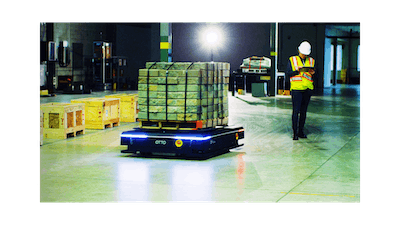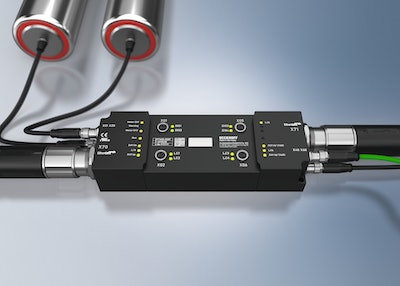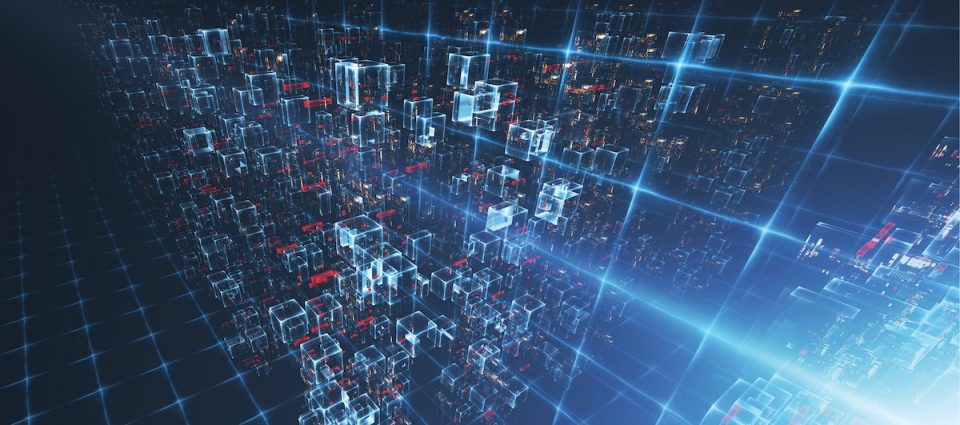Manufacturing technology advances have
extended the realm of automation beyond
plant floor sensors, controllers, vision
systems, and robotics into closely connected
data collection and analysis using artificial intelligence.
These technologies enable a “smart factory”
to self-optimize and adapt to conditions in
real-time. Despite these advances, warehouse and
related material moving operations tend not to be
nearly as modernized as plant floor operations.
“If you look inside the most modern environment,
warehouse or factory, material handling,
broadly speaking, is mostly analog,” says Matthew
Rendall, CEO of Otto Motors, a maker of autonomous
mobile robots (AMRs). “Any place where
a forklift truck is driving something around, it is
highly analog. That means the amount of data you
have at your fingertips to analyze is limited. For
decades, operators have been grasping at low accuracy,
low frequency, and expensive-to-capture
data trying to figure out how to run a continuous
improvement program.”
For example, you can go into a factory or a
warehouse today and still see industrial engineers
sitting in lawn chairs at an intersection in the plant
with a clip board, pencil, and stopwatch to monitor
material flows, says Rendall. “It is an expensive
thing to request of a highly trained industrial engineer,
so it doesn’t get done frequently,” he says.
Which means the process, by its nature, is not
as exact as it should be; plus, it’s rarely updated.
But this antiquated, analog surveying method
is shifting in response to the decreasing cost of
computer storage, increasing compute power,
and new tools that target warehouse and distribution
operations.
 The Otto 1500 autonomous mobile robot for heavy payloads includes front and rear 3D cameras for advanced obstacle avoidance and continuous mapping for a real-time visual of the facility.
The Otto 1500 autonomous mobile robot for heavy payloads includes front and rear 3D cameras for advanced obstacle avoidance and continuous mapping for a real-time visual of the facility.
Otto Motors is delivering tools to help industrial
engineers automate the study of time and motion—and it comes in the form of the AMR. “The
remarkable contrast that an AMR brings to the
table is that we have sub-inch and sub-second
level accuracy, and the marginal cost to collect
an additional survey is zero,” Rendall explains. “So
you are able to run industrial engineering time and
motion studies on steroids at all times.”
The AMRs from Otto Motors are designed for
material handling in the manufacturing and warehouse
operations in a free-movement manner.
In an automotive warehouse, for example, there
could be 30,000 parts moving across the facility.
“It’s a symphony of motion,” Rendall says. “[With
data from the AMRs] we are able to harness insights
about how those 30,000 parts are moving
in order to create a smarter traffic network.”
The foundation of Otto Motors’ AMR is a proprietary version of the simultaneous localization
and mapping (SLAM) algorithm, which relies
upon cameras and laser scanners to develop a
photorealistic floor plan.
“Think of an AMR as having a photographic
memory. As it’s driving around it is constructing
a picture-perfect representation of that environment
in its memory,” Rendall says. Using that
underlying localization and mapping, you can plot
out where a vehicle has traveled. “As a result, the
side benefit [of an AMR] is that we have one of
the most sophisticated data collection machines a
factory or warehouse has ever seen, patrolling the
floor 24/7,” Rendall says.
The AMRs operate with fleet management
software which includes a feature called “factory
replay,” providing a time-lapse recap of the entire
day’s production. The software can take a 16-hour
operation and collapse it down to five minutes,
which provides an industrial engineer with a birds-eye
view of the floor and the ability to rewind,
fast-forward, and zoom in to a certain time during
an incident—as well as before and after—to extract
insights about ultimate root causes of problems
on the floor.
Another company, 634AI, offers an AI-driven
technology called Maestro, which is designed to
safely orchestrate the movement of AMRs and
coordinate situational reactions to create a more
efficient and safer environment. Using off -the- shelf, Power-over-Ethernet ceiling-mounted
cameras, and proprietary computer vision technology,
Maestro pulls video streams from different
cameras to create a grid on the floor.
Those videos are stitched together to create a
real-time map of the facility. Then, deep learning
AI coupled with computer vision algorithms draw
semantic analytics from data on the factory floor.
“This data can be productivity-related information
providing real-time safety alerts, near-miss
analyses, task allocation, and the ability to instigate
and navigate a robot’s autonomous capabilities
live on the factory floor,” says Shlomi Hatan,
634AI’s vice president of business development
and operations.
Every factor in the process is identified, classified, tracked, and managed by Maestro, including
raw materials, mobile robots, forklifts, boxes, and
even people. “Designed to be hardware-agnostic,
Maestro is interoperable with other systems to
enhance company workflows on a universal scale,”
Hatan explains. “The general rule is, if Maestro sees
it, it can be tracked and controlled in real time.”
Hatan adds that Maestro’s control capabilities
can be extended to deliver custom, AI-generated
productivity propositions. For example, Maestro
can display forklift slow zones to locate bottlenecks
and interferences for vehicles and workers,
informing them of obstacles to help shorten travel
times. It can also track the traveled distance and
driving hours of forklifts and robots to identify
underutilized resources or assure timely maintenance
of equipment. It can even alert operators of
incorrectly positioned materials and pallets.
Collecting all this information internally and
creating a map of material movement can also
help companies with supply chain struggles.
“There’s an interesting relationship between
transparency and automation,” Rendall says. “We
can’t influence what time the parts arrive on the
loading dock. But if we are responsible for all the
material handling that happens once the materials
hit the receiving dock, we can use a QR code or
RFID tag to scan the inventory. That inventory is
only touched by a machine, and when that’s the
case, you should be able to see within inch- and
second-level accuracy where every nut, bolt, and
screw is inside the operation. So you have a much
better handle of what inventory you are working
with inside your operation to more intelligently
use the resources available to you.”
 The Beckho EP7402—a compact, IP67- rated motor-driven roller controller—can be used for AS/RS and other applications inside distribution centers.
The Beckho EP7402—a compact, IP67- rated motor-driven roller controller—can be used for AS/RS and other applications inside distribution centers.
and retrieval
Industrial control suppliers are also adding intelligence
to automated storage and retrieval systems
(AS/RS) used in warehouses and distribution
centers.
Beckhoff Automation, for example, offers a
shuttle control system for AS/RS applications
in compact form factors. This system includes
TwinCAT Machine Learning software to reduce
energy consumption while optimizing acceleration
and deceleration of the shuttles. “The machine
learning (ML) functionality automates
this so there is no human intervention required
to achieve the process improvements,” says
Doug Schuchart, Beckhoff’s global material
handling and intralogistics manager.
In addition, the EtherCAT communication
protocol used in this system allows information
to be collected in large quantities and stored in a
database on a Beckhoff controller. That data can
then be transmitted to the cloud.
“Once at the enterprise level or the cloud, data
science software can be used to develop ML inferences
for equipment optimizations and predictive maintenance applications. These ML inferences
can then be deployed using TwinCAT Machine
Learning to be executed in the PLC in real time,”
Schuchart explains.
Dealing with dock delays
AMRs coupled with AI can increase productivity
and safety inside operations. And machine
learning coupled with PLCs can improve order
fulfillment and throughput. But what happens
when the truck doesn’t show up at the receiving
dock? Traditional warehouse management systems
(WMS) don’t have the ability to recalculate
everything when there are shipping delays, or if
there are too many shipments and not enough
docks, or if inventory is in the wrong building.
To address such issues, AutoScheduler.AI has
developed a cloud-based intelligent warehouse
orchestration platform that integrates with existing
WMS, ERP, and even yard management
systems to provide dynamic dock scheduling,
proactive cross-docking, and prescriptive analytics
that balance inventory flow and drive labor
efficiencies. “Our goal is to be the brain of the
warehouse,” says AutoScheduler.AI CEO and
co-founder Keith Moore.
The work started as a project with Procter &Gamble (P&G). P&G operates one main plant in
Ohio that uses seven nearby satellite warehouses
for storage. Across this campus, the project
noted more than 250 outbound full-vehicle
shipments per day and, of those, 85% were drop
and hook, and 15% were live load. These operations
require manual efforts that are completed
based on who is scheduled and the need for the
day. But volatility in the production schedule
and volume made it difficult to plan, resulting in
an inefficient operation.
Using the AutoScheduler.AI technology, P&G
doubled shipments from the plant directly to
customers without increasing inventory, reduced
shuttle moves involving outside warehouses by
nearly 50%, reduced workforce planning from
eight hours to 20 minutes per day.
That experience prompted Moore to turn this
into a scalable system for any warehouse or distribution
center operation to provide analytics
that describe what is happening, predict what
will happen, and prescribe an optimal plan based
on that information.
Every few minutes, AutoScheduler looks at the
current situation and then runs “what-if” scenarios
based on inventory and constraints to maximize
flow through the building. “We pull information
from the WMS and other systems, run the
optimization, and push it back into the execution
system. So when someone scans a pallet…our plan
flows straight through to the floor, and nobody
even knows we exist,” says Moore.
The AutoScheduler technology is exactly the
kind of cognitive toolsets that Stephen Laaper,
a principal and manufacturing strategy leader at
Deloitte Consulting, says is coming to day-to-day
warehouse operations.
“Supply chains will continue to be pressed and
stretched in various ways for the foreseeable future,”
Laaper observes, noting that more actionable
information is imperative. “Because of that,
the nature of these solutions are becoming increasingly
important.”


